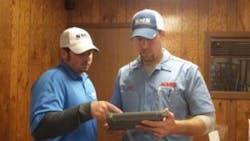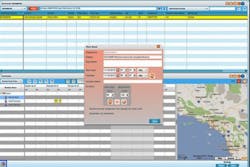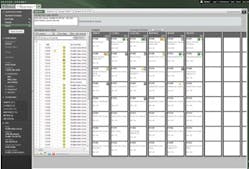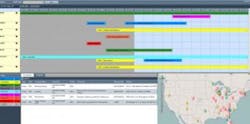This field from Spectrum software shows the location and status of multiple technicians. Photo: Dexter+ChaneySamsa has been using
Service Max software for field service automation for two years. Prior to that time, service work was tracked by paper work orders, which Samsa eventually converted to electronic forms. But, he says, it “just wasn’t a great system,” so it was time for a change.“With paper or electronic forms, you really have to keep track of the work orders you send out, and those that are closed,” he shared. “Some were being forgotten and never billed. I would give a technician a work order, but there would be no way to track it until the job was complete. It was easy to miss things. There were also no checks and balances between billable time on work orders and time sheets.”
Samsa Mechanical Service is reaping the benefits of its “real time” revolution.
“Everything is up-to-date, in real time. If somebody enters their work for today, I can see it instantly,” Samsa says.
Samsa describes to customers the process it has established with Service Max as a “service cloud.”
“It’s an Internet-based system that allows us to issue work orders, and track services, customer equipment, materials, replacement parts, work performed, type of failures, preventive maintenance and service contracts electronically, and in real time on an iPad from the field,” he says. “This unique system, using analytics, allows the company to recognize common failures and service procedures company-wide, based on any criteria.”
The service cloud offers many benefits to Samsa’s many customers.
“If a customer calls with a problem, we generate a work order, which is instantly dispatched to the technician providing all of the site, contact and problem details. Because we track all equipment serviced by serial number, as soon as the technician is onsite, he can enter the serial number into the iPad and see a complete work history on that specific piece of equipment. Samsa can also customize Service Max.
“In the training sessions, they teach you how to do that, so you can track the information you need and want. Also, I have the ability to limit the information employees see through their ipad to whatever I want them to see,” he says.
Floating on a Cloud With Spectrum Version 14
Another long-respected name in mechanical HVAC contracting is that of
Yale Mechanical, Minneapolis, MN. Founded in 1939, Yale’s expertise extends to commercial, industrial, and institutional buildings.
Dori Seegar is the accounting manager at Yale Mechanical, where they’re using Version 14 of
Spectrum Construction Software by Dexter+Chaney, a cloud-based system. They’ve been Spectrum customers since 2008. A cloud-based system is a bit challenging, but Seegar says it’s working well.
“There are, of course, differences to get used to with a cloud system, after using it another way for all those years, but the accessibility it provides from any location is a big positive,” she says. “Also, we have the ability to grow within the software, as far as deploying tablets in the field. And we can view plans in the field by being in the cloud. They can be viewed on iphones, but tablets work best.“The biggest advantage to Version 14 is its ability to access information. If you have a question that can only be answered with data, it’s an advantage to be able to get it immediately, rather than wait to get back to the office,” she says.
Seegar adds that the new Version 14 loses nothing in terms of information capability. It can access information related to jobs, equipment service history, and even parts inventory, if the user wishes to have that access.
“It was a big change to go to the web-based platform. As the days go by we’re more happy with it,” Seegar says.
“With Spectrum, our operations and management personnel are able to get the information they need right away. They don’t need to wait for somebody in accounting to write up a report or spread sheet. We have approximately 65 custom reports that we’ve built using InfoLink or Crystal Reports, because it’s easy to do that with Spectrum. The databases are ODBC (open data base connectivity) compliant, and we can access it and put it into different formats. With Spectrum we can get a lot more work done. “
Mobile Function Keeps It All Together
Ray Thomas, business development director for
MSI Data, Mequon, WI, believes HVAC contractors are looking to control four key business functions with field automation software:
• the back office
• the field
• mobile operations
• integration of all functions with the accounting/Enterprise Resource Planning (ERP) environment. MSI Data provides businesses with all-in-one field service management software, which they call













